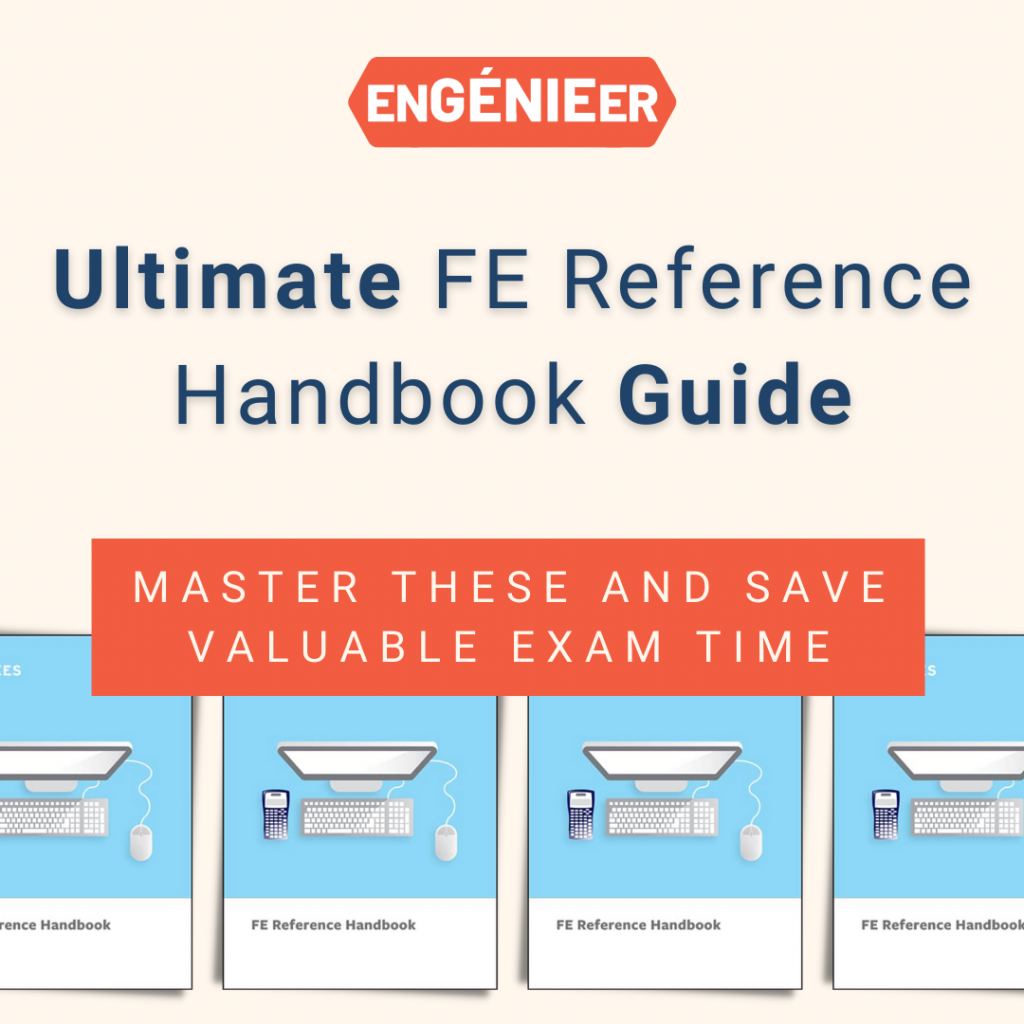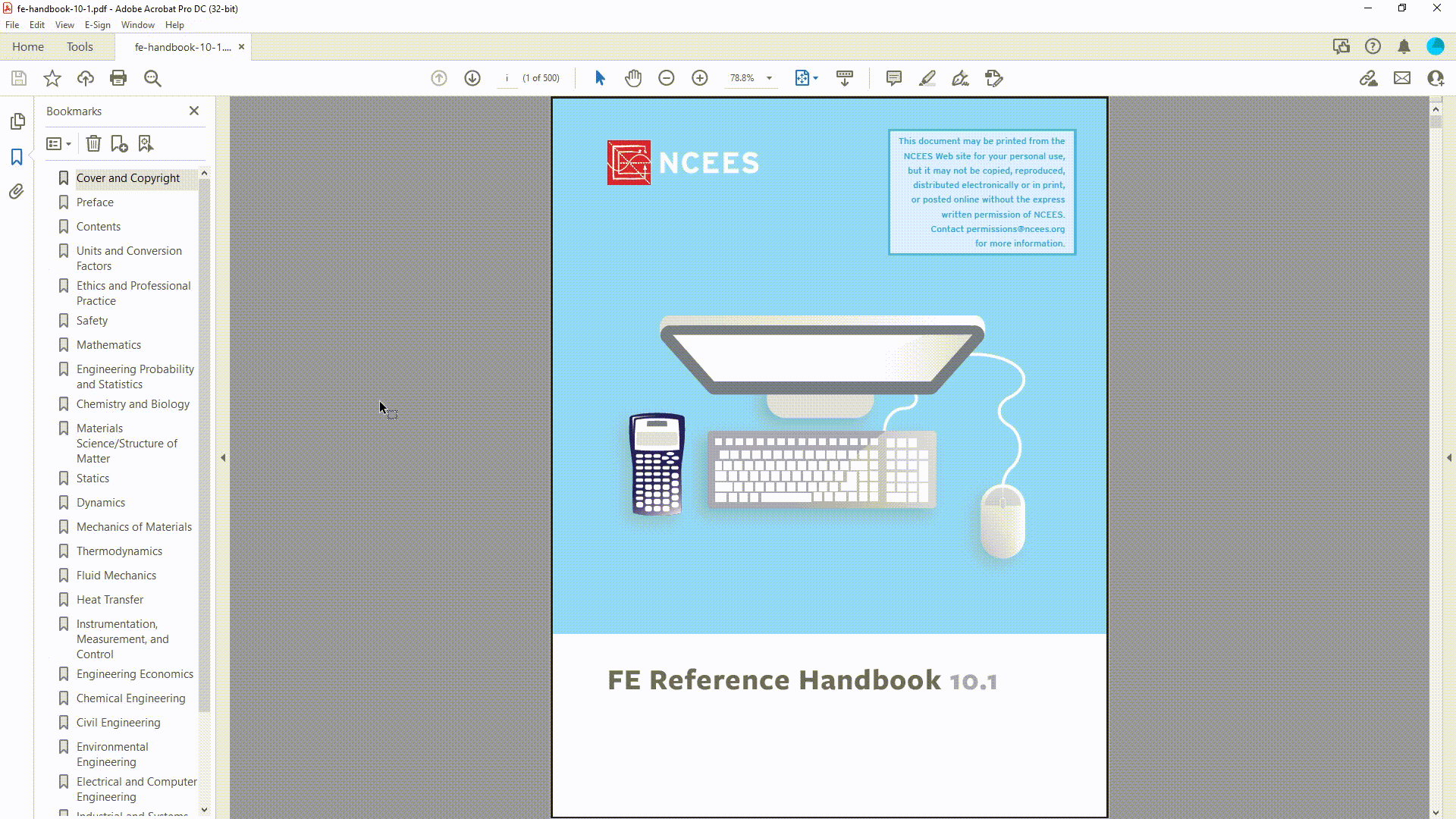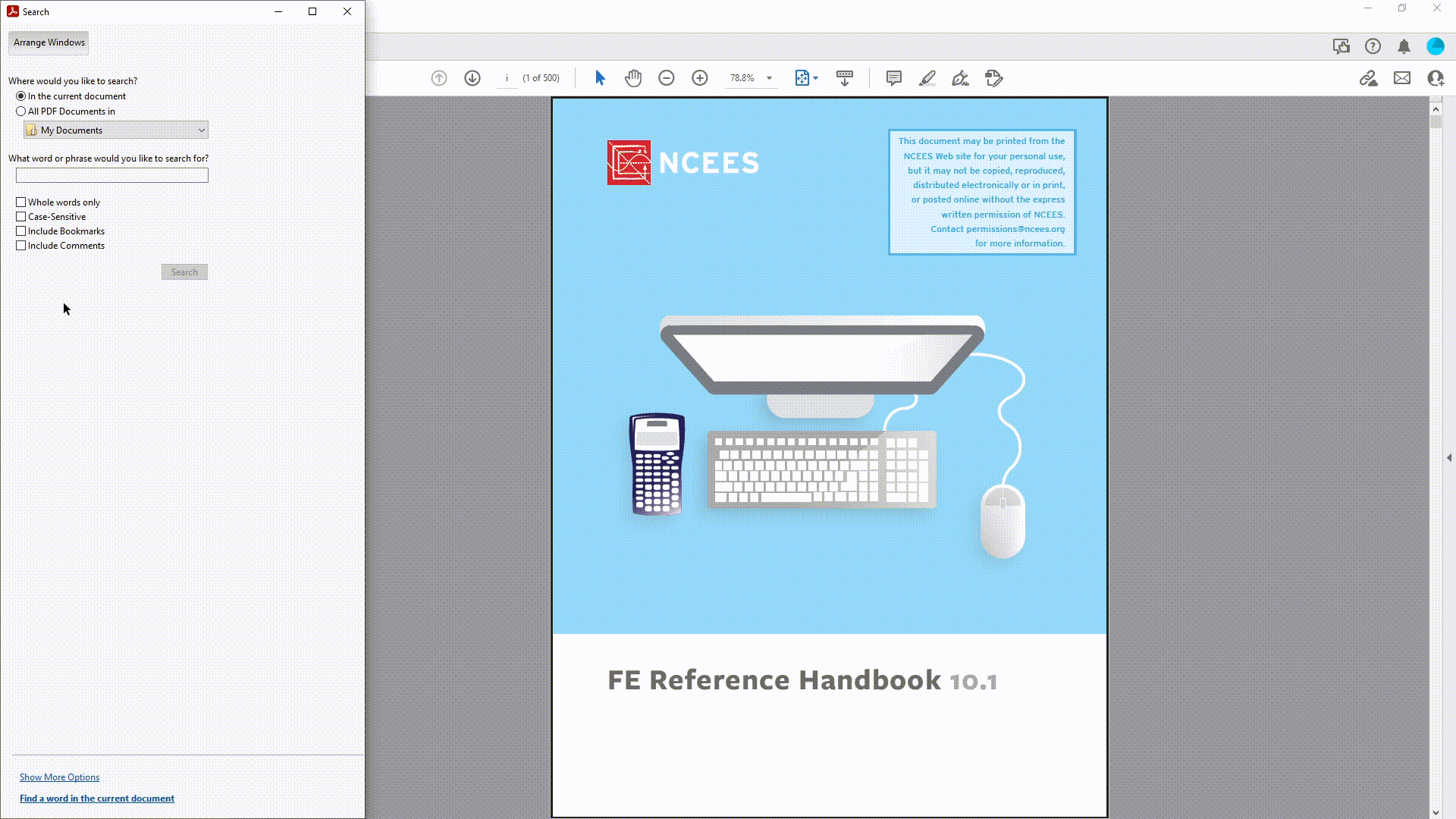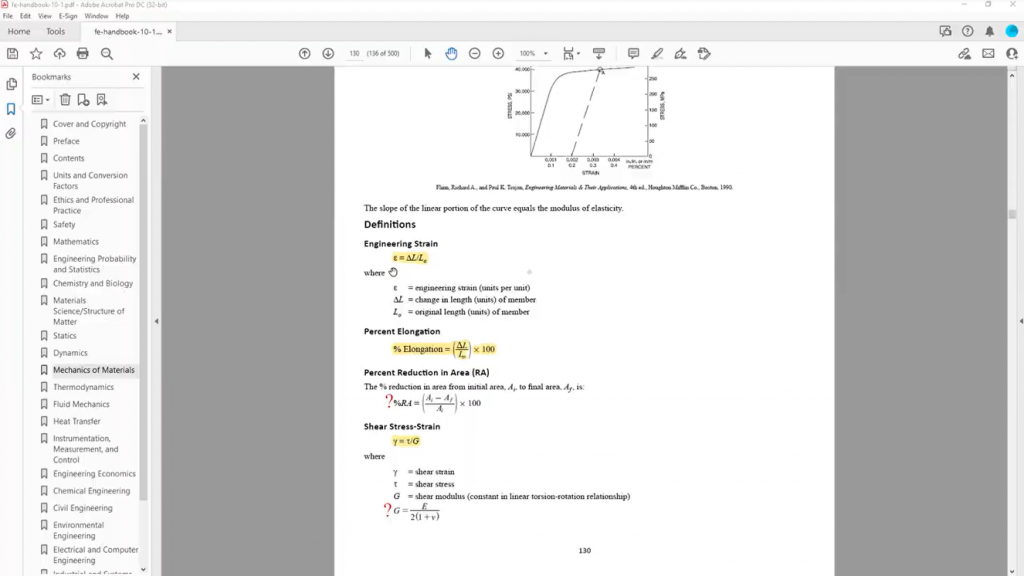Ultimate FE Reference Handbook Guide. Master these and Save Valuable Exam Time.

Knowing the ins and outs of the FE reference handbook is key to anyone trying to pass their Fundamentals of Engineering exam. In this guide, you’ll find out precisely what the FE reference handbook is, how to use it, tips to use while preparing to take your FE exam and hands-on guidance on what it’s like searching within the FE reference handbook.
Plus, I want to show you many methods of finding equations, units, and tables that will help save you valuable time on exam day. With this guide, you will know how to study for the FE exam and be prepared to pass!
What is the new FE reference handbook?
What the heck is the reference handbook?
The FE reference handbook is a book that the NCEES provides for your FE exam. It has a ton of equations that you will use to solve the questions on your exam.
Did you know the FE reference handbook also tells you what will be on your exam? By knowing what is within the handbook, you will have a better understanding of the material you should be studying.
Where do you find the FE reference handbook?
Download your digital copy of the FE reference handbook after creating an account with the NCEES. Make sure you download the latest version, which was recently updated after the FE exam changed in July 2020. The NCEES also updates the version if there are changes or corrections to make.
To download, log into your NCEES account and click on “View reference handbooks”.

Watch this video to get an in-depth look at the FE reference handbook.
Should I buy the hard copy of the FE reference handbook?
While in your NCEES account, you will notice that the NCEES also offers the reference handbook as a hard copy. Now the question is should you get it? I don’t recommend my students get the hard copy of the reference handbook because you will have access to the reference handbook as a PDF, not as a hard copy or a book on the FE exam. While preparing for the exam, it’s vital that you get used to the exam environment before exam day.
What happens if you study from the FE reference handbook book, not PDF?
We had an enGENIEer student who recently passed his FE exam after taking an enGENIEer course, and when he first started preparing for his FE, he actually used the hard copy. Then, two months before his FE exam, he decided to switch to PDF. He later told me that he really struggled through that transition. He also noted that it took him a while to get used to the PDF format.
If you are a book person, I recommend that you get the book and make sure that you use the reference handbook as a PDF while preparing. So you are getting yourself familiar with the PDF as you will use it on exam day.
Types of Questions on the FE Exam
The FE exam has two types of questions:
- Conceptual questions
- Practical problems
While studying engineering concepts, make sure that you look up the keywords on the reference handbook and check and see if those concepts are mentioned. If not mentioned, make sure that you write them down, review them, and remember them for your exam.
When tackling practical problems during your FE exam prep, it’s also important to use the FE reference handbook for several reasons. First, this will help you remember where the equations are on the FE reference handbook, which means you’ll be able to find the equations faster during your exam and save you time now while studying.
Second, you will know which equation you have covered and which you haven’t. The FE reference handbook, in a way, tells you what’s going to be on your exam, so going over as many equations as possible is going to help you pass your FE exam.
Third, there are a lot of FE resources, like books and FE exam prep courses, that are outdated and irrelevant to the FE exam. In addition, they often cover equations that are not in the FE reference handbook. When you face these problems, you probably wonder if you have to memorize the equation for your FE exam. The answer to that is no; you’re not expected to memorize any long or complex equations for the FE exam. This is why it’s important to always use the FE reference handbook so that way you don’t waste time studying something that’s not going to be on your exam.
You’re not expected to memorize any long or difficult equations for the FE exam. This is why it’s important to always use the FE reference handbook so that way you don’t waste time studying something that’s not going to be on your exam.
Kenza
Five tips on how to use the FE reference handbook effectively
Using the FE reference handbook effectively is essential to successfully study for the FE exam and save time during your exam. We also know that the computers during the exam are often slow, and it takes way too much time to navigate through the reference handbook.
If you’re feeling stuck on using the handbook while preparing to pass your FE exam, use these five tips and spend less time searching and more time solving problems.
Tip 1: Use the FE search box on the screen.
My first tip is to get used to the search box similar to the one you will have in your FE exam. Right now, if you are using the FE reference handbook as a PDF, you are probably using the CTRL+F search box. During your FE exam, that search box looks different.
To have the same search box like the one in your FE exam, you should type CTRL+Shift+F. It will look like the image below.

To use the CTRL+Shift+F effectively, be careful not to get stuck while looking up keywords. For example, let’s say we search for “momentum,” we get a lot of results. If we were to click on all of them, it would be a waste of time, especially if the computer is slow.
Take a little time to learn how to quickly figure out which of the results you’re looking for during studying.
It’s crucial that you use the CTRL+Shift+F while studying for your FE exam because you will learn faster ways to locate equations on the reference handbook without clicking so many results.
Tip 2: Double-check your spelling.
When you look up the keywords on the search box, ensure that you’re not misspelling anything. This will lead you to the wrong results. For example, if we type “moment” instead of “momentum,” the first couple of results will be for “moment.” This will waste your time. Also, if you misspelled “momnt,” you could get no results. So before you hit search, make sure that you check your spelling.
Tip 3: Memorize conversion units.
There are some conversion units that you will often encounter during the FE exam. I recommend that you memorize these units. And here’s why. Let’s say you are doing a problem under hydraulics, which is under civil engineering, and you have to convert from gallons per minute to cubic feet per second. In that case, you would have to go to the unit section, grab the conversion factor, and come back to the hydraulics section to finish up the problem.
All this searching is a waste of time. So memorizing some of the common unit conversions can save you a lot of time during the FE exam.

Watch this video, where together we work on a unit conversion cheat sheet for statics.
Download the sheet and work with me through the conversions.
Tip 4: Highlight equations you’ve covered in the reference handbook.
This tip came from Praneetha, a former enGENIEer student and now teammate. Highlight the equations each time you do a new problem. This way, you know which equations you have covered and which you haven’t.

Now, make sure you go back to the equations you haven’t covered and get familiar with them. Look them up, see how they get applied and understand the concepts behind them.
Remember, the FE reference handbook kind of tells you what might be on your FE exam. So covering as many questions as possible will increase your chances of passing your FE exam.
Tip 5: Find the equations faster.
This final tip is to find ways to find the equations faster. Finding these tricks is not something that you can do quickly. It takes a lot of time and practice but will help you pass your FE exam. There are tricks to help you get to any section or equation faster than looking at the keywords in the search box. By using the FE reference handbook all the time while studying for the FE, you will discover these methods for yourself.
As we move into the next section, you will find some that will work for you and help you move through the FE reference handbook faster. Try them for yourself as you study.
How to find equations faster on the FE exam
Having tricks to help you find equations faster will save you precious exam time and prevent you from memorizing everything. The methods below are based on sections under FE Civil, Mechanical, and Other Disciplines. However, you can still apply the same exact tips to any FE exam.
Method 1: Locating the tables
I show you that most tables are located at the end of the FE reference handbook sections in this method. By going to the next section and scrolling up, you can get to tables quicker than searching. Watch this video to see how I found the moment of inertia for rectangle, mass and centroid equations, mass moment of inertia, moody chart, and more.
Method 2: Sometimes, it’s better to search for the keywords
Not all subjects have tables at the end; sometimes, they are in the middle of the section. By clicking on the next section and scrolling up won’t work in this situation. I recommend you memorize these locations so that you spend more time on questions and less time scrolling on exam day. Watch this clip to take a look at the Math section.
Method 3: Memorize certain equations location
In this method, I encourage you to try to remember – just approximately – where equations are within the FE reference handbook.
During studying, take a second look at where the equation is and what is near in the handbook. Then, watch this video where I walk you through some examples, including doing a problem on dynamics and the problem is on the rectilinear motion.
Knowing where the big concepts are within the handbook will let you find it fast, grab the equation, and solve the problem. Thus, saving you time searching and more time able to solve problems.
TIP: If you are taking FE Civil or FE Environmental, I recommend that you take some time to go over the environmental engineering section. Environmental engineering is an extensive section with many concepts. It covers air pollution, wastewater, water, treatment plants, and landfill.
With that being said, you do not have to remember where all of the equations are in the reference handbook. Sometimes it is just faster to look up the keywords. But sometimes, it is just quicker to know where certain equations are, grab it and move on.
Method 4: Get familiar with the Civil Engineering section
The civil engineering portion of the FE reference handbook is a large section and contains a lot of topics. For example, geotechnical engineering, structural analysis, structural design, hydrology, water resources, transportation, surveying, and construction. In this video, I walk you through the different sections and examples of what you will be looking for while studying and taking your FE exam.
Become a FE reference manual expert and pass your FE exam
Having the right material and knowing how to use it will prepare you for your FE exam. And becoming an expert with the FE reference handbook will help you pass your FE exam. Both for studying and for exam day. But, the only way to really know the FE reference handbook is to use it every time you study. Set yourself up for success and mimic the exam environment by only using the PDF.
Are you are looking for more tips, tricks, and guides on how to study for the FE exam? Sign up for our email newsletter and prepare yourself to pass your FE exam!
Sign Up For More FE Tips & Pass Faster
The weekly newsletter for engineers ready to pass the FE Exam.






